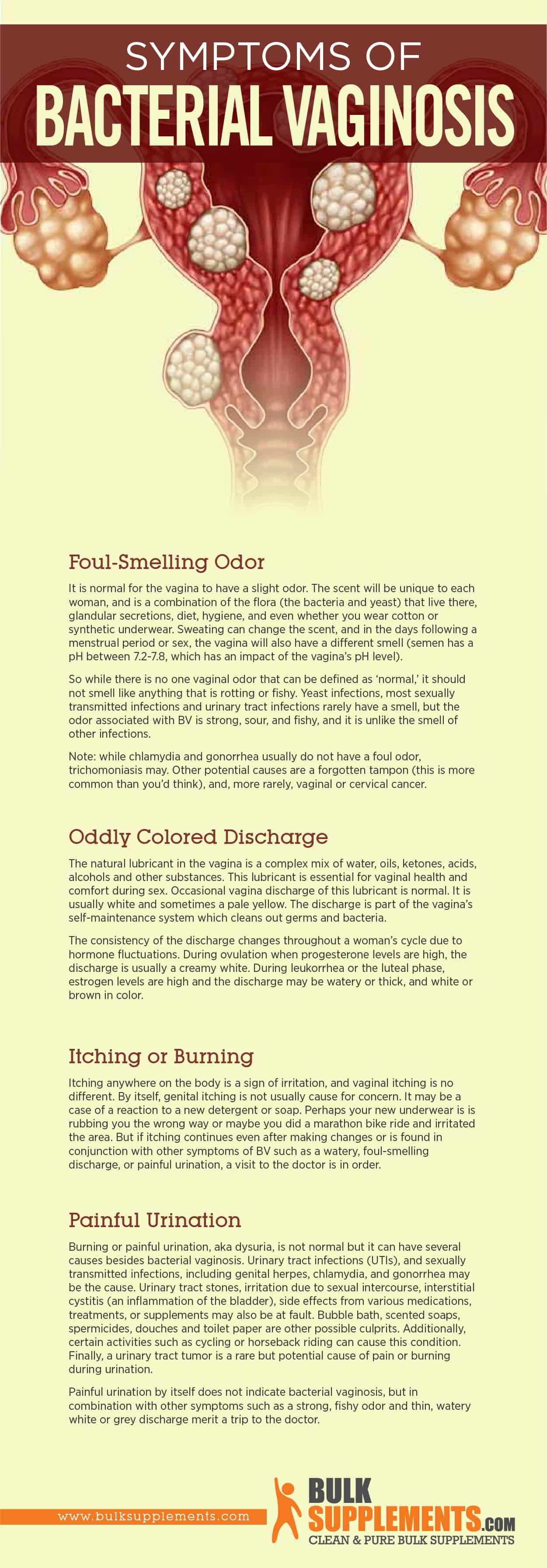Bacterial Vaginosis: Symptoms, Causes & Treatment

Bacterial Vaginosis
What is Bacterial Vaginosis?
Bacterial vaginosis (BV) is caused by an overgrowth of bacteria in the vagina. It is the most common vaginal infection in women — even more so than yeast infections. Almost 30 percent of women between the ages of 15 and 44 are affected by BV. According to the CDC, more than 20 million American women suffer from bacterial vaginosis each year. While this number makes it sound like developing BV is almost a given, there are plenty of steps you can take to reduce your chances.
One symptom of BV is a thin grey or white discharge and a sour, fishy smell. This is different from a yeast infection, which produces a thick cottage cheese-like discharge. Another symptom of BV is itchiness in or around the vagina. Burning or painful urination, pelvic or abdominal pain similar to the pain felt with a urinary tract infection may also occur. This can be a sign that the BV is traveling up and causing an infection in the pelvis.
Wondering when to see a doctor? If you have any of these symptoms, especially if the symptoms are associated with a foul odor or fever, make the call. You should also see a doctor if you have a new sexual partner or multiple partners as the symptoms of BV are similar to sexually transmitted infections. Definitely see a doctor if you try self-treatment, but the symptoms do not go away. Surprisingly, the vast majority of women, some 84 percent, show no signs of bacterial vaginosis.
Diagnosing Bacterial Vaginosis
Diagnosis may be determined with a vaginal swab, pelvic exam and/or simply by symptoms. Antibiotics are frequently used to treat BV. Five doses of the vaginal suppository metronidazole often works best. Special attention is needed with oral metronidazole as it cannot be taken in conjunction with certain other medications or alcohol because the combination can cause vomiting, nausea and other unpleasant side effects.
Left untreated, BV can lead to pelvic inflammatory disease (PID) which is an inflammation of the entire female reproductive system, including the uterus, fallopian tubes and ovaries. PID can cause serious complications, including infertility.
Relation to Sexually Transmitted Diseases
While BV is not considered to be a sexually transmitted disease, it does increases a woman’s risk of contracting sexually transmitted diseases such as gonorrhea, chlamydia and HIV. Pregnant women with BV run the potential risk of going into premature labor and having a baby with low birth weight. Women with BV have an increased risk of infection following surgery to the reproductive system.
Bacterial Vaginosis Symptoms
Foul-Smelling Odor
It is normal for the vagina to have a slight odor. The scent will be unique to each woman, and is a combination of the flora (the bacteria and yeast) that live there, glandular secretions, diet, hygiene, and even whether you wear cotton or synthetic underwear. Sweating can change the scent, and in the days following a menstrual period or sex, the vagina will also have a different smell (semen has a pH between 7.2-7.8, which has an impact of the vagina’s pH level).
So while there is no one vaginal odor that can be defined as ‘normal,’ it should not smell like anything that is rotting or fishy. Yeast infections, most sexually transmitted infections and urinary tract infections rarely have a smell, but the odor associated with BV is strong, sour, and fishy, and it is unlike the smell of other infections.
Note: while chlamydia and gonorrhea usually do not have a foul odor, trichomoniasis may. Other potential causes are a forgotten tampon (this is more common than you’d think), and, more rarely, vaginal or cervical cancer.
Oddly Colored Discharge
The natural lubricant in the vagina is a complex mix of water, oils, ketones, acids, alcohols and other substances. This lubricant is essential for vaginal health and comfort during sex. Occasional vagina discharge of this lubricant is normal. It is usually white and sometimes a pale yellow. The discharge is part of the vagina’s self-maintenance system which cleans out germs and bacteria.
The consistency of the discharge changes throughout a woman’s cycle due to hormone fluctuations. During ovulation when progesterone levels are high, the discharge is usually a creamy white. During leukorrhea or the luteal phase, estrogen levels are high and the discharge may be watery or thick, and white or brown in color.
Unlike a yeast infection which has a thick, cottage cheese-like discharge, BV often has a thin, grey or white discharge. A discharge that has a strong yellow color may indicate either bacterial vaginosis or a sexually transmitted infection.
An irregular period may cause a brown discharge, but if it keeps happening, it may be a sign of cervical or uterine cancer. Green means go — to the doctor. A green discharge is often an indication of a sexually transmitted infection.
So while the consistency and color of the discharge may vary, symptoms such as itching, burning, irritation or a foul odor are signs that all is not well and it might be time to call the doctor.
Itching or Burning
Itching anywhere on the body is a sign of irritation, and vaginal itching is no different. By itself, genital itching is not usually cause for concern. It may be a case of a reaction to a new detergent or soap. Perhaps your new underwear is rubbing you the wrong way or maybe you did a marathon bike ride and irritated the area. But if itching continues even after making changes or is found in conjunction with other symptoms of BV such as a watery, foul-smelling discharge, or painful urination, a visit to the doctor is in order.
Painful Urination
Burning or painful urination, or dysuria, is not normal but it can have several causes besides bacterial vaginosis. Urinary tract infections (UTIs), and sexually transmitted infections, including genital herpes, chlamydia, and gonorrhea may be the cause. Urinary tract stones, irritation due to sexual intercourse, interstitial cystitis (an inflammation of the bladder), side effects from various medications, treatments, or supplements may also be at fault. Bubble bath, scented soaps, spermicides, douches and toilet paper are other possible culprits. Additionally, certain activities such as cycling or horseback riding can cause this condition. Finally, a urinary tract tumor is a rare but potential cause of pain or burning during urination.
Painful urination by itself does not indicate bacterial vaginosis, but in combination with other symptoms such as a strong, fishy odor and thin, watery white or grey discharge merit a trip to the doctor.

Causes of Bacterial Vaginosis
It is normal for bacteria, both ‘good’ (lactobacilli) and ‘bad’ (anaerobes), to live in the vagina, so what causes bacterial vaginosis? A healthy pH level for the vagina is 3.8-4.5, which is fairly acidic, but the bacteria which cause BV prefer a higher level of 6-7. This is different from yeast, which prefers a drop in pH. So anything that raises pH levels in the vagina can increase the risk of an overgrowth of bacteria. This includes douching, perfumes in laundry detergent, soaps and feminine sprays or simply being pregnant.
SEE ALSO

Lactose Intolerance: Symptoms, Causes & Treatment
Smoking also raises the chance of developing BV, as do sexually transmitted diseases, which means that a higher number of sexual partners also increases the risk. Sexual intercourse can change the makeup of the bacteria and yeast found in the vagina along with pH levels, and it is this combination which can cause an overgrowth of bacteria. While sex is a common cause of BV, it is important to note that you do not need to be sexually active in order to have BV.
For example, douching is not necessary and can negatively alter the balance of bacteria in the vagina. This also holds true for feminine sprays. Unscented pads and tampons are ideal. Be sure to change them frequently.
Bacterial Vaginosis Remedies and Supplements
A supplement of garlic tablets was found in studies to be an effective natural alternative for treating bacterial vaginosis. Garlic contains over 30 different compounds with antibacterial properties. The usual dose is 650 mg taken twice daily with meals, or as recommended by your doctor.
Apple cider vinegar contains probiotics, enzymes and vitamins that can rebalance the pH of the vagina, controlling the amount of ‘bad’ bacteria while encouraging the growth of the ‘good.’ It does not interact with antibiotics. To make a douche of apple cider vinegar, combine 2 cups of water with 1 teaspoon of apple cider vinegar. Use once a day, before showering. Healing may take 1-2 weeks.
Tea tree oil is another natural remedy. Do not use essential oils directly on the skin without diluting first. If you experience irritation with tea tree oil, discontinue use.
It is important to always practice safe sex. Limit sexual partners, use a condom and wash after sex using unscented soap.
Cotton underwear is another smart move. Nylon and other synthetics trap moisture and heat, creating the perfect environment for anaerobic bacteria to thrive. Moreover, wiping from front to back helps to prevent the accumulation of harmful bacteria.
The Bottom Line
Bacterial vaginosis is caused by an overgrowth of bacteria. It is a common infection that may be caused by many things, including perfumes, tight clothes, and sex. While antibiotics are frequently prescribed, natural remedies such as garlic have been shown to be an equally effective treatment method.



